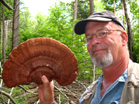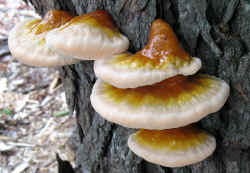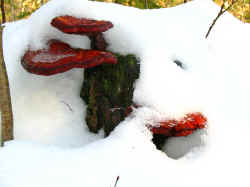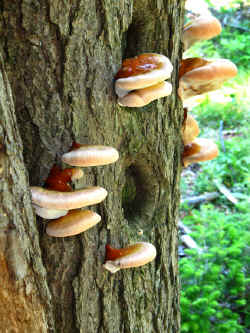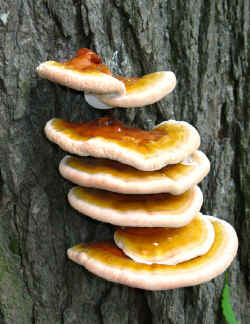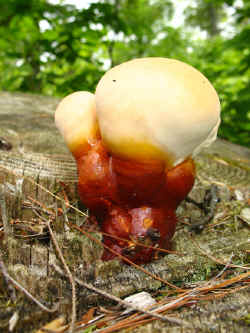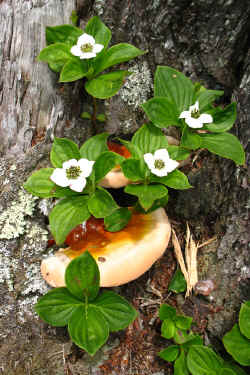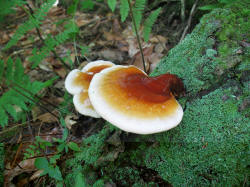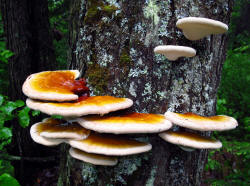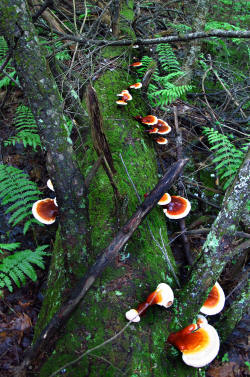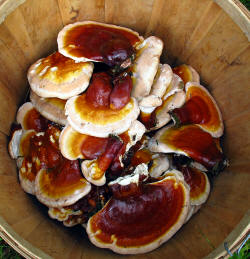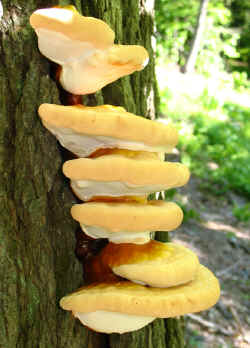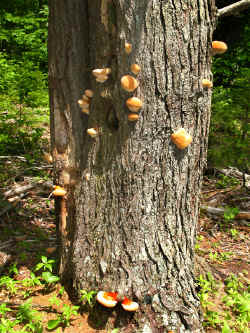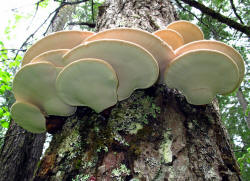|
|
A New England and Eastern Canada Edible and Medicinal Mushroom Resource |
||||
|
Reishi / Lingzhi
Ganoderma tsugae, the hemlock reishi mushroom is quite common in central Maine and elsewhere in the northeast. It grows on dead or dying eastern hemlock, a very common tree. It is very showy with it's bright red colors and it's varnished look that darkens as it matures. It contains protein-bound polysaccharides known to have medicinal properties. Ganoderma lucidum looks practically identical, grows on hardwoods, but is very rare in this area. Cap (pileus) 1 1/2 - 15 inches across and 1/2 - 1 1/2 in. thick. Knobby at first with whitish tan to orange tones becoming deep red, fan or kidney shaped with zones. It can have a varnished appearance. The margin (edge) may be yellow/tan or whitish. At maturity the cap can become covered with the brown spores. Pores are whitish to light tan on the outside but often brown on the inside 1/8-3/8 in. thick. Stem (stipe) Nonexistent to several inches long and often angled. Flesh Whitish in Ganoderma tsugae often bruising brownish when cut. Brown in G. lucidum. Spores Brown
When and where to find them (ecology) Ganoderma tsugae will be found on dead or dying eastern hemlock but may grow on other conifers beginning in Late May or early June and continuing well into July or later. Trees that woodpeckers have been working on in shadier locations are a good bet. Woodpeckers are likely suspects in the transmission of spores/mycelium from tree to tree. They will be found on the side of the tree or occasionally growing on the ground from a root. They will grow on the same tree for many years. Mark it with your GPS. One tree on my property I have monitored for several years seems to develop fruit bodies lower on the tree each year. Since the fruits were very close to the ground last year I'm wondering if they will come back this year. The substrate may be all used up. Update: 6-07. This has been a bumper crop year for G. tsugae. My tree that I thought might be used up has 30 fruit bodies on it (so much for theories). See the recent images on this page and continue to the photo gallery. The similar Ganoderma lucidum will be found on hardwoods. Preparation Mushroom field guide author Bill Russell put me on to eating the tender edge of this mushroom when they are first emerging. The very young softer fruit bodies may be thin sliced, sautéed and eaten. They look like a whitish to tan knob as they emerge. There should be no orange or red or varnish showing yet. It is really quite tasty sautéed with oil and butter. The mushroom grows back if you don't cut it too close (see the gallery photos). Powder of the dried fruit body can be steeped into a tea or made into a tincture or liquor. A tincture can be made using alcohol and water. 80 or 100 proof vodka a good easy choice for making the tincture. Fill up a container such as a bottle or jar at least 1/2 with dried powder then fill it to the top with the vodka and allow it to sit for a few days or up to 2 weeks. Strain off the liquid and run it through an unbleached coffee filter. That yields a "single extraction". You may take the leftover single extracted marc (mash) and decoct (boil for 2 hours or more) in water. Reduce the liquid by half and add it to your first extraction making a stronger "double extraction" maintaining an alcohol concentration of around 25%. Chris Hobbs' book Medicinal Mushrooms: An Exploration of Tradition, Healing, & Culture (Herbs and Health Series) covers this in detail. The dried fruit bodies may be ground up for use. Running it through a hand crank meat grinder is hard work reminiscent of grinding a piece of rubber or foam insulation. Pieces that pass through the grinder in rubbery little hunks go into the blender for further chopping. Big pieces may kill your blender though. Some opt to slice it thinly for preparation. The tea is pleasant but bitter requiring a bit of honey to be palatable. The tincture/liquor is quite good reminding me of scotch whiskey. A bit of sweetness may help here too. Teas or tinctures will have a pleasant reddish color. Recently I have been making India pale ale with reishi. Basically, you follow a normal ale recipe replacing the dried pulverized mushroom for boiling hops. I decoct it on the side for at least half an hour and add it to the wort at the end.
Comments As always try a small bit first. The medicinal properties of Ganoderma have a long history in Chinese medicine. Ganoderma tsugae is known as songshan lingzhi by the Chinese. More recent scientific studies indicate that both species may be useful in treating some types of cancers, especially breast cancer. Ganoderma tsugae has been found to have similar properties to G. lucidum. Much of the medicinal value may be concentrated in the extremely tough rubbery stem. If you have health issues or take medication there is a possibility of interaction. Check with your doctor. Ganoderma tsugae can be used for dyeing wool, some fabrics, or paper and will yield a rust color when ammonia is used as a mordant with wool. When you find them, you may have to wait for several weeks for them to reach full size. Since you will likely be monitoring them for a while, some patch maintenance is a good idea. Kill any slugs you see in the area and try to brush off any other bugs that may be eating them. Since they are often on trees with woodpecker holes sawdust often falls on top of the cap that should be brushed or blown off. Small plants growing near may need to be weeded or trimmed so the fruit bodies do not end up with grasses, stems or twigs growing through the fruit body as seen below in the bunchberry photograph. It's best not to remove any shading plants. More pictures! Ganoderma Gallery Find more information here: Ganoderma
tsugae at MushroomExpert.com
Copyright 2013 Mushroom-Collecting.com. All rights reserved. Use of this site will constitute your acceptance of the disclaimer. |
